If you own a male dog, you might have seen that his testicles are occasionally hidden inside his scrotum. Due to a disorder known as cryptorchidism, which occurs in certain dogs, one or both of their testicles have not fully descended from the abdomen.
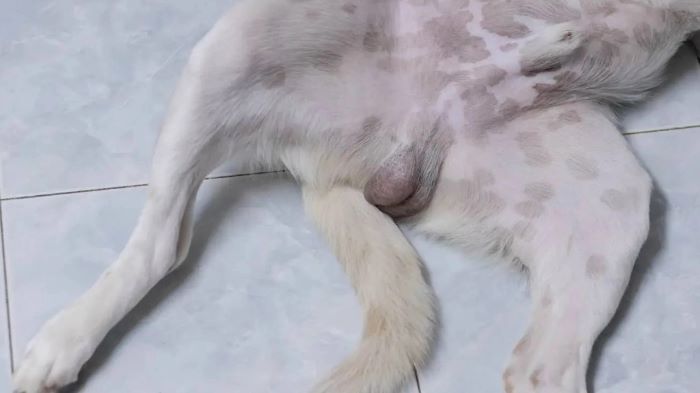
- The testicles of a dog cannot be made to fall naturally using any known techniques.
- Surgical intervention is typically required if your dog has cryptorchidism.
- In order to avoid potential health concerns like testicular cancer or hormone-related difficulties that might arise from retained testicles, neutering is typically advised.
In this article, We’ll go through the risks and dangers of cryptorchidism, its causes, and both natural and medical methods for causing a dog’s testicles to fall out. You might be able to support your dog’s reproductive system by using these techniques.
How to Make Your Dog’s Testicle Drop?
If your dog has a retained testicle, you may be wondering how to make it drop into the scrotum. In this section, we will discuss four methods that may help you achieve this goal.
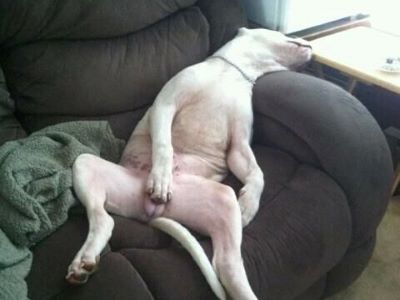
Method #1: Massage for Dog’s Testicle Drop
Massage is one of the natural remedies that might assist your dog in reducing testicle shedding.
The dog’s testicles are moved toward the scrotum by applying light pressure on the region beneath them during a massage.
The muscles and ligaments holding the testicles in place may be relaxed and blood flow may be stimulated as a result.
a). Benefits of massage for dog’s testicle drop: You can do massages at home since they are easy and non-intrusive. It could make your dog more at ease and lessen any pain or discomfort brought on by the retained testicle.
It could also make your dog happier and more attached to you.
b). Limitations of massage for dog’s testicle drop: Massage is not a guaranteed method to make your dog’s testicle drop.
It may not work if the testicle is too far away from the scrotum or if there are other factors that prevent it from descending, such as hormonal imbalance, genetic defects, or inflammation.
Massage may also cause irritation or injury to the testicular area if done too roughly or frequently.
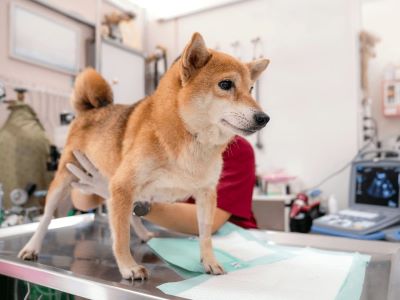
Some Tips and Precautions for massaging your dog’s testicles:
- Consult your veterinarian before trying massage on your dog. They can advise you on how to do it properly and safely, and monitor your dog’s progress.
- Use gentle and smooth movements when massaging your dog’s testicles. Do not squeeze, pull, or twist them.
- Massage your dog’s testicles for about 1-2 minutes at a time, several times a day. Do not overdo it or force your dog to cooperate if he resists or shows signs of discomfort.
- Stop massaging your dog’s testicles if you notice any bleeding, swelling, redness, or pain. Contact your veterinarian immediately if these symptoms persist or worsen.
- Reward your dog with praise, treats, or toys after each massage session. This will help him associate massage with positive experiences and make him more willing to cooperate.
Method #2: Use Cold Pack for Dog’s Testicle Drop
Using a cold pack is another natural remedy that might aid in your dog’s testicle dropping.
A cold pack is a tool that may be used to provide cold to the testicular region and includes ice or gel that can be frozen.
This may ease the testicles’ fall into the scrotum and assist minimize swelling and irritation there.
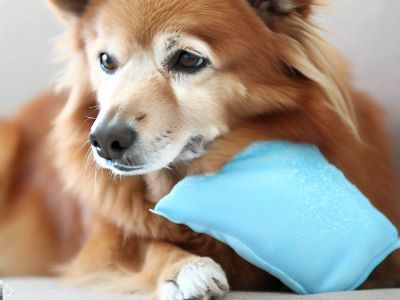
a). Benefits of using cold pack on dog’s testicle: A cold pack is a quick and low-cost home remedy. It can ease your dog’s discomfort and any pain brought on by the retained testicle.
By lowering blood flow and oxygen demand, it can help stop additional harm to the testicular tissue.
b). Limitations of using cold pack on dog’s testicle: A cold pack is not a guaranteed method to make your dog’s testicle drop.
It may not work if the testicle is too far away from the scrotum or if there are other factors that prevent it from descending, such as hormonal imbalance, genetic defects, or infection.
A cold pack may also cause irritation or injury to the skin or nerves in the testicular area if used too long or too frequently.
Some Tips and precautions for using a cold pack on your dog’s testicles:
- Consult your veterinarian before trying a cold pack on your dog. They can advise you on how to use it properly and safely, and monitor your dog’s progress.
- Use a commercial cold pack or make your own by wrapping ice cubes or frozen vegetables in a towel or plastic bag. Do not apply ice directly to your dog’s skin as it can cause frostbite.
- Apply the cold pack to your dog’s testicles for about 10-15 minutes at a time, several times a day. Do not overdo it or leave it on for too long as it can cause tissue damage or nerve injury.
- Check your dog’s skin for any signs of redness, blisters, or numbness after using the cold pack. Contact your veterinarian immediately if these symptoms persist or worsen.
- Reward your dog with praise, treats, or toys after each cold pack session. This will help him associate the cold pack with positive experiences and make him more willing to cooperate.
Method #3: Hormonal Stimulation for Dog’s Testicle Drop
Another method that may help your dog’s testicle drop is hormonal stimulation.
Hormonal stimulation involves giving your dog injections or pills that contain hormones that can mimic the natural hormones that trigger testicular descent.
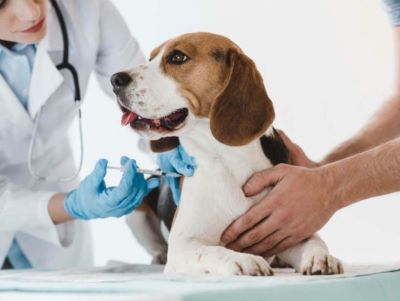
These hormones include human chorionic gonadotropin (hCG) and gonadotropin-releasing hormone (GnRH).[1]
a). Benefits of hormonal stimulation for dog’s testicle drop: Some dogs with mild or partial cryptorchidism[2] may benefit from hormonal stimulation, a non-surgical treatment.
By promoting the growth and operation of the spermatic cord and testicular tissue, it could aid in your dog’s testicle dropping.
Moreover, it could increase your dog’s fertility and lower the chance of testicular cancer.
b). Limitations of hormonal stimulation for dog’s testicle drop: Hormone stimulation does not always result in the testicles of your dog dropping.
It might not function if the testicle is too far from the scrotum or if there are other obstacles, including genetic flaws, infections, or torsion, that hinder the testicle from descending.
Side effects of hormonal stimulation might include an increase in hostility, enlargement of the prostate, or allergic responses.
If your dog has undergone neutering or has low levels of natural hormones, hormonal stimulation might not be successful.
Some Tips and precautions for using hormonal stimulation on your dog’s testicles:
- Consult your veterinarian before trying hormonal stimulation on your dog. They can advise you on the dosage, frequency, and duration of the treatment, and monitor your dog’s progress and response.
- Follow your veterinarian’s instructions carefully when giving your dog hormonal injections or pills. Do not overdose or underdose your dog as it can cause serious complications.
- Check your dog’s testicles regularly for any signs of swelling, pain, or descent. Contact your veterinarian if you notice any changes or if the treatment does not seem to work after a few weeks.
- Be aware of the possible side effects of hormonal stimulation on your dog’s behavior and health. Contact your veterinarian if you notice any signs of aggression, prostate problems, or allergic reactions.
- Consider neutering your dog after the treatment if the testicle does not drop or if you do not want to breed your dog. Neutering can prevent further complications and health risks associated with cryptorchidism.
Method #4: Surgery for Dog’s Testicle Drop
The most definitive and recommended method to treat cryptorchidism is surgery. Surgery involves removing or relocating the retained testicle(s) under general anesthesia.
The surgery is usually performed when the dog is young, ideally between 6 and 12 months of age, as waiting too long can increase the risk of complications and make the surgery more difficult.
a). Benefits of surgery for dog’s testicle drop: Surgery is the only permanent solution for cryptorchidism. It can prevent further health problems such as testicular cancer, torsion, infection, or infertility.[3]
It can also eliminate any pain or discomfort caused by the retained testicle. It can also reduce unwanted behaviors such as aggression, marking, or roaming.
b). Limitations of surgery for dog’s testicle drop: Surgery is an expensive, intrusive procedure that takes time to recuperate from.
Risks include bleeding, infection, and negative anesthetic reactions. Both the personality and look of your dog could be impacted.[4]
The fact that surgery may also render your dog infertile may be a problem if you intend to breed your dog.
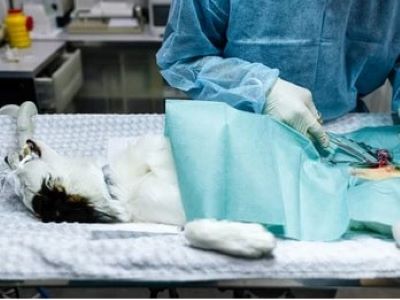
Some Tips and precautions for preparing for and recovering from surgery:
- Consult your veterinarian before deciding on surgery for your dog. They can advise you on the pros and cons of the procedure, and perform any necessary tests or exams to ensure your dog’s health and safety.
- Follow your veterinarian’s instructions carefully before and after the surgery. You may need to fast your dog for a certain period of time before the surgery, and provide pain medication, antibiotics, or anti-inflammatory drugs after the surgery.
- Check your dog’s incision site daily for any signs of swelling, discharge, or infection. Contact your veterinarian immediately if these symptoms persist or worsen.
- Prevent your dog from licking, biting, or scratching the incision site by using an Elizabethan collar (cone) or a bandage. You may also need to limit your dog’s activity and exercise for a few days or weeks until the incision heals.
- Schedule a follow-up visit with your veterinarian to monitor your dog’s recovery and remove any stitches or staples. Your veterinarian may also perform a blood test to check your dog’s hormone levels after the surgery.
FAQs
What to do if my dogs balls don’t drop?
If your dog’s balls don’t drop by the time he is 6 to 8 months old, he may have a condition called cryptorchidism, which means that one or both of his testicles are retained in his abdomen or groin.
This can cause health problems such as infertility, testicular cancer, or torsion. You should consult your veterinarian as soon as possible if you suspect your dog has cryptorchidism.
Can a dogs testicle go back up?
A retractile testicle is a condition where the testicle can move back and forth between the scrotum and the abdomen. It is usually harmless but may increase the risk of torsion.
Can a dog with 1 testicle have puppies?
A dog with 1 testicle can have puppies but may have reduced fertility and pass on cryptorchidism gene. It is better to neuter him.
Why is my dog born with one testicle?
Cryptorchidism is a genetic condition that affects the development and descent of testicles. It may be linked to the X chromosome and inherited from the father.
Conclusion
In this article, We talked about the effects of male dog cryptorchidism. How to make a dog’s testicle drop with veterinarian assistance using four techniques that we have already discussed. Massage, cold therapy, hormone stimulation, and surgery are some of these approaches.
Each approach has its own benefits and limitations, and it might not be effective for all dogs. As a result, it’s crucial to ask your veterinarian for advice before using any procedure and to obey their suggestions.
Your dog’s problem may be diagnosed by your vet, who can also help you choose the best course of action and keep an eye on your dog’s development and health.
You can reduce subsequent difficulties and enhance your dog’s quality of life by treating cryptorchidism as soon as feasible.
References:
- Driancourt, M., & Briggs, J. R. (2020). Gonadotropin-Releasing Hormone (GnRH) Agonist Implants for Male Dog Fertility Suppression: A Review of Mode of Action, Efficacy, Safety, and Uses. Frontiers in Veterinary Science, 7. – Frontiers
- Madden, A., DVM. (2022). Cryptorchidism in Dogs. – PetMD
- Memon, M. A. (2007). Common causes of male dog infertility. Theriogenology, 68(3), 322–328. – ScienceDirect
- Vititoe, K. (2013, July 1). Anuria due to inadvertent prostatectomy during cryptorchidectomy. PubMed Central. Retrieved June 28, 2023, from – NCBI

Julia is a Board Certified Veterinary Nutritionist, practicing veterinarian in a non-profit animal hospital and feline sanctuary located in Rochester, NY. She is also a full-time veterinary advisor at DogLikesBest. She focuses on writing healthcare-related topics including dog foods, treats, veterinary diets, food for specific healthcare features, etc. Moreover, any article on DogNeedsBest that has to concern feline health in any way, goes under her scrutiny before being published.


